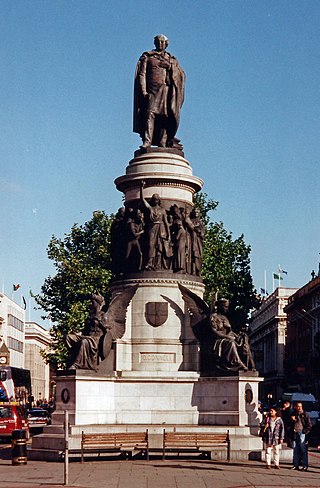Related Research Articles

O'Connell Street is a street in the centre of Dublin, Ireland, running north from the River Liffey. It connects the O'Connell Bridge to the south with Parnell Street to the north and is roughly split into two sections bisected by Henry Street. The Luas tram system runs along the street.

John Miller Andrews, was the second prime minister of Northern Ireland from 1940 to 1943.
Events from the year 1953 in Ireland.
Gerard A. Hayes-McCoy (1911–1975) was an Irish historian regarded as one of the leading Irish historians of his generation.

A series of riots in Dublin on 25 February 2006 was precipitated by a proposed march down O'Connell Street of a unionist demonstration. The disturbances began when members of the Garda Síochána attempted to disperse a group of counter-demonstrators blocking the route of the proposed march. The situation escalated as local youths joined forces with the counter-demonstrators.

An Tóstal was the name for a series of festivals held in Ireland in the 20th century. Inaugurated in 1953 as a celebration of Irish life, it continued on until 1958 when it died out in most centres except Drumshanbo.

Sir Anthony Brutus Babington PC (NI) was an Anglo-Irish barrister, judge and politician.
Robert John Babington, DSC, QC was an Ulster Unionist Party politician, who served as the member of the House of Commons of Northern Ireland for North Down from 1969 to 1972, and a county court judge. He was born in Dublin.
The Rt Rev. BrutusBabington (1558–1611) was an Englishman who became the Church of Ireland Bishop of Derry.

Edward McGuire was an Irish painter.
Mabel Young was a British artist, who spent her career painting in Ireland.
Yvonne Jammet was a French landscape painter and sculptor, who spent her career in Ireland. With her husband, Louis Jammet, she ran the well-known Dublin-based French restaurant, Restaurant Jammet.
Thomas George Wilson FRCSI FRCSE FRCS FACS FRSM MRIA HRHA was an eminent Anglo-Irish surgeon and medical administrator specialising in otorhinolaryngology, a field to which he made significant contributions. Wilson was also an accomplished author, artist and sailor. He was known as 'T.G' and was a leading figure in Dublin society until his sudden death in 1969.

Babington is the name of an Anglo-Irish and English gentry family. The Anglo-Irish branch of the family is still extant today.

George Vaughan Hart, KC was an Anglo-Irish academic who served as Regius Professor of Feudal and English Law at Trinity College Dublin from 1890 to 1909.
Anthony Patrick Babington was a British author, judge and Army officer.

Thomas Jackson (1807–1890) was a 19th-century Irish architect who contributed to the iconic baroque look of Belfast. He was described as being the foremost Belfast architect of his day.

Joshua Pim (1748–1822) was a Dublin merchant active in the cotton trade in Dublin in the late 18th and early 19th century, who made significant input into setting up the Dublin Chamber of Commerce.

Hume Babington was a Church of Ireland clergyman, serving as the rector at Moviddy, County Cork, for 53 years from 1833 to 1886, and a proponent of secular education in Ireland.
References
- ↑ Froggatt, Peter. "Thomas George Wilson (1901 - 1969)". The Dictionary of Ulster Biography. Ulster History Circle.
- ↑ Accountancy Age, Vol 7. No 34. Pg 12-13, 27 August 1976
- ↑ Accountancy Age, Pg 15, 16 September 1977
- ↑ Management Decision, Pg 28-32, Spring 1968
- ↑ The Evening Herald, 8 February 1956
- ↑ The Irish Independent, 8 February 1956
- ↑ The Evening Mail, 8 February 1956
- ↑ "O'Connell Bridge and the 'The Bowl Of Light'". 19 March 2012.
- 1 2 Dublin Opinion, May 1953, Vol XXXIII
- ↑ The Sunday Independent, November 1953
- ↑ Pim, Sheila (1957). Other People's Business. London: Hodder & Stoughton. p. 5 – via Internet Archive.
- ↑ "The Dual Nature of Human Behavior". Archived from the original on 12 October 2016. Retrieved 11 October 2016.
- ↑ "Nietzsche 1844-1900: Right Questions, Wrong Answers".